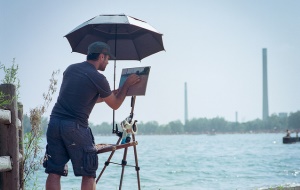Are you thinking of studying Architecture?

If you’ve always had a yearning for the opportunity to create things that will be around long after you’re gone, a degree in Architecture could be for you.
It’s a challenging degree that prepares you for a respected (and lucrative) profession doing meaningful work – and, as there’s always a need for new buildings, it’s a profession that you can be confident will always be in demand.
What kind of things can I expect to study?
Architecture combines practical skills with academic study, which makes it interesting and varied. Note that some universities offer Architecture as a BA course, others as a BSc; both can be used towards qualification as a professional architect, but check that the course is accredited with the Royal Institute of British Architects (RIBA).
Design work

A fundamental component of an architecture degree is the development of practical design skills, so much of your time is likely to be occupied by studio-based projects and tuition that revolves around designs that range from minute details of buildings to entire cities. In addition to teaching you to think about architecture in the right way, this will develop your drawing and draftsmanship, as well as cultivating effective design processes. You’ll also pick up skills such as architectural modelling and digital illustration.
The different aspects of architecture
There are many considerations in architecture, meaning that in addition to design, you’ll also learn about things like structural engineering, construction, building materials and so on. You might also study more specialised areas such as sustainable architecture, town planning, technology and conservation. Some courses teach you the management skills needed for managing a building site.
Architectural history and theory
Though the focus of an Architecture degree tends to be on practical skills, there is a certain amount of abstract thinking involved. As part of your learning, you’ll develop an understanding of human nature and spatial experience, as well as the principles of environmental design and how architecture is adapted to different environments and contexts, such as rural or urban areas. Different universities place different levels of emphasis on the study of the history of architecture, but this is likely to feature on your course to a greater or lesser degree.
What do I need for an Architecture degree?

A mixture of humanities and science/maths subjects at A-level is necessary to gain a place on an Architecture course, with Maths particularly desirable. Art, History of Art or Design and Technology would also come in useful, and Physics is valuable preparation for the engineering components of studying Architecture. If you don’t have Maths or Physics at A-level, you’ll definitely need high grades in these subjects at GCSE to secure a place on an Architecture course; competition for places is fierce.
You will also need strong drawing skills, and you’ll need to be comfortable with drawing freehand and thinking and drawing in 3D. You may have to present a portfolio at interview to demonstrate your existing drawing skills; you’ll develop specific skills needed for architectural drawings at university, so your drawing doesn’t have to be perfect right away – but you do need be able to show admissions tutors that your drawing has the potential for development.
What skills will I acquire?

An Architecture degree poses the intellectual challenges of both arts and science degrees, and as such, it develops a range of useful skills that can be applied to many walks of life. Creativity is essential, and yours will grow as you become more adept at architectural design. There’s a lot of group project work on an Architecture course, so your teamwork skills will flourish. Problem solving and analytical skills will also be honed, particularly in the context of needing to come up with innovative architectural solutions to the demands of various different environments.
Will I get to travel as part of my degree?
You will probably go on a work placement as part of your architecture course, and this can be anywhere in the world; many universities offer four-year courses with the option to spend a year abroad at an affiliated school of architecture or on a placement. The degree also involves site visits to different kinds of building, so there’s plenty of scope for getting away from your desk during an architecture degree.
What careers are possible with an Architecture degree?
The main career this degree prepares you for is, of course, being an architect. Some graduates do stop studying architecture after completing a three-year degree, though the majority carry on to qualify as architects. However, this degree is also excellent preparation for a variety of design-related careers, as well as offering transferable skills from the arts and sciences that can be applied in other careers for which a degree is necessary.
Related degrees

If you’re interested in architecture, but think that this subject isn’t quite what you’re looking for, you might also be interested in the following:
- Art and Design courses – you may prefer an alternative design-focused course that allows you to be more flexible in the media with which you develop your practical and creative skills.
- Classical Archaeology – this subject includes, among other things, the study of architecture in the ancient world.
A final thought on Architecture
Most people who study Architecture do so because they want to become architects. It takes seven years to qualify as an architect, so it’s an educational path that will require a great deal of patience and commitment. It takes five years of study at university – a three-year undergraduate course followed by two years of Masters degree – and two years of practical experience to register as a professional architect. Some courses are four years, to include a year of practical experience required by RIBA. This counts as RIBA Part I, with Part II being the Masters followed by another year of practical experience, and Part III being a final qualifying exam. More information on the route to becoming a professional architect is available from the Royal Institute of British Architects.
Image credits: banner; design; drawing; baton pass; artist.
